Begonia Escargot, scientifically known as Begonia rex-cultorum, is a captivating and sought-after houseplant. Its unique name, “Escargot,” derives from the spiral pattern on its leaves, resembling a snail’s shell. This begonia variety is beloved for its stunning foliage and adds an elegant touch to any indoor space. Here’s a closer look at what makes it special:
Key Features of Begonia Escargot:
- Leaf Spiral: The defining characteristic of Begonia Escargot is its striking, spiraled leaves. They exhibit a swirl of silver-gray with deep green veining, creating a mesmerizing visual effect.
- Compact Size: Begonia Escargot is a compact plant, making it perfect for small living spaces or as a desk companion. It typically grows to a height of about 12-18 inches.
- Low Maintenance: This begonia variety is relatively low-maintenance, making it an excellent choice for both beginners and experienced plant enthusiasts.
- Unique Coloration: The leaves feature a lustrous shine, adding to the plant’s overall appeal. The striking contrast between the silver and green makes it a real eye-catcher.
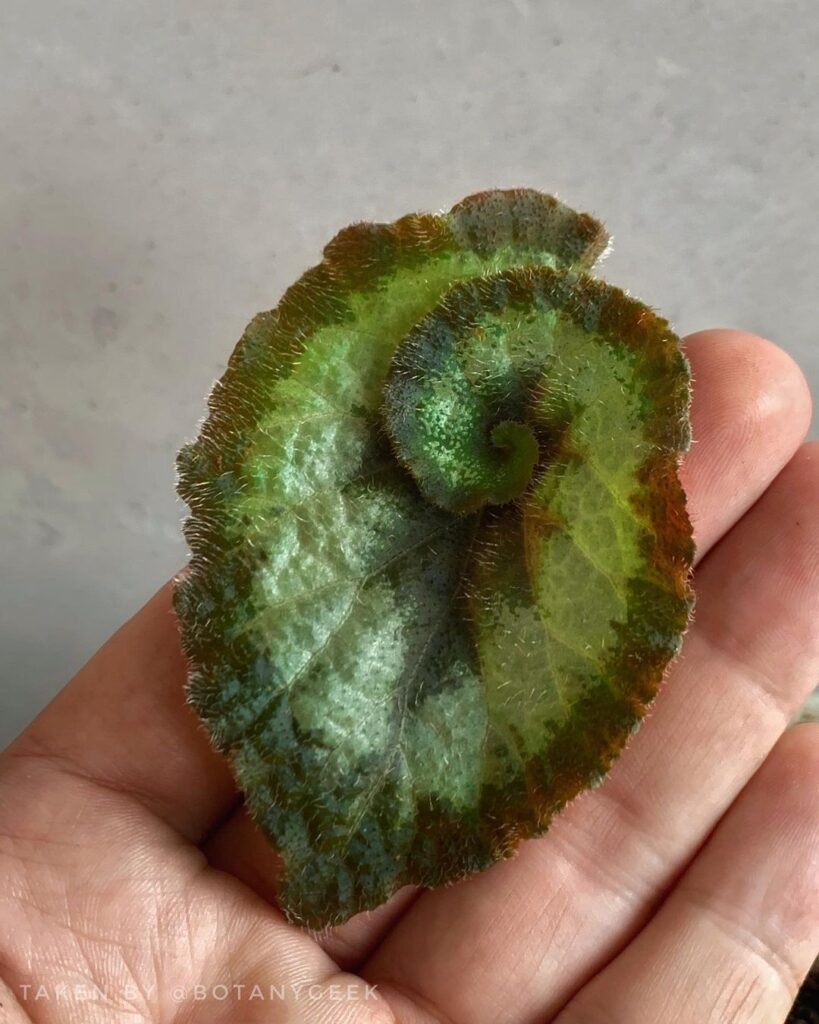
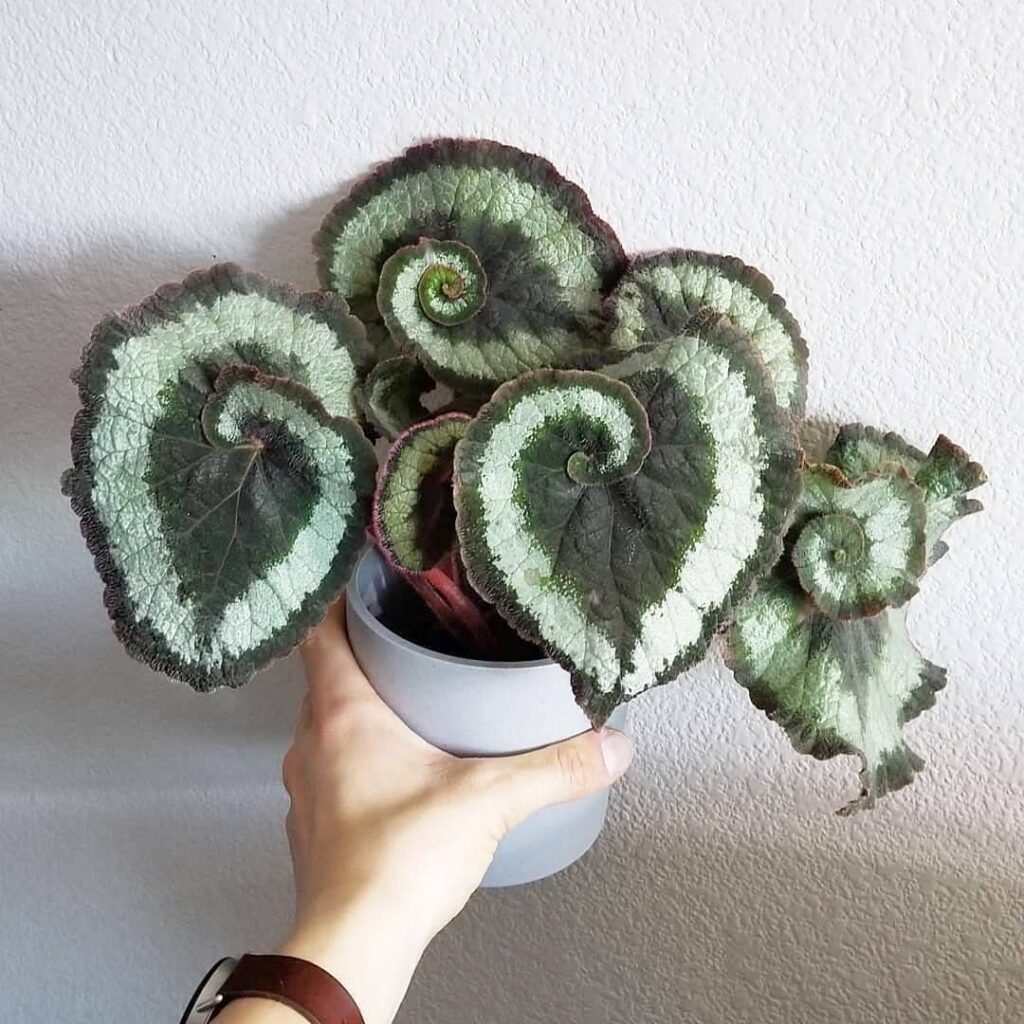
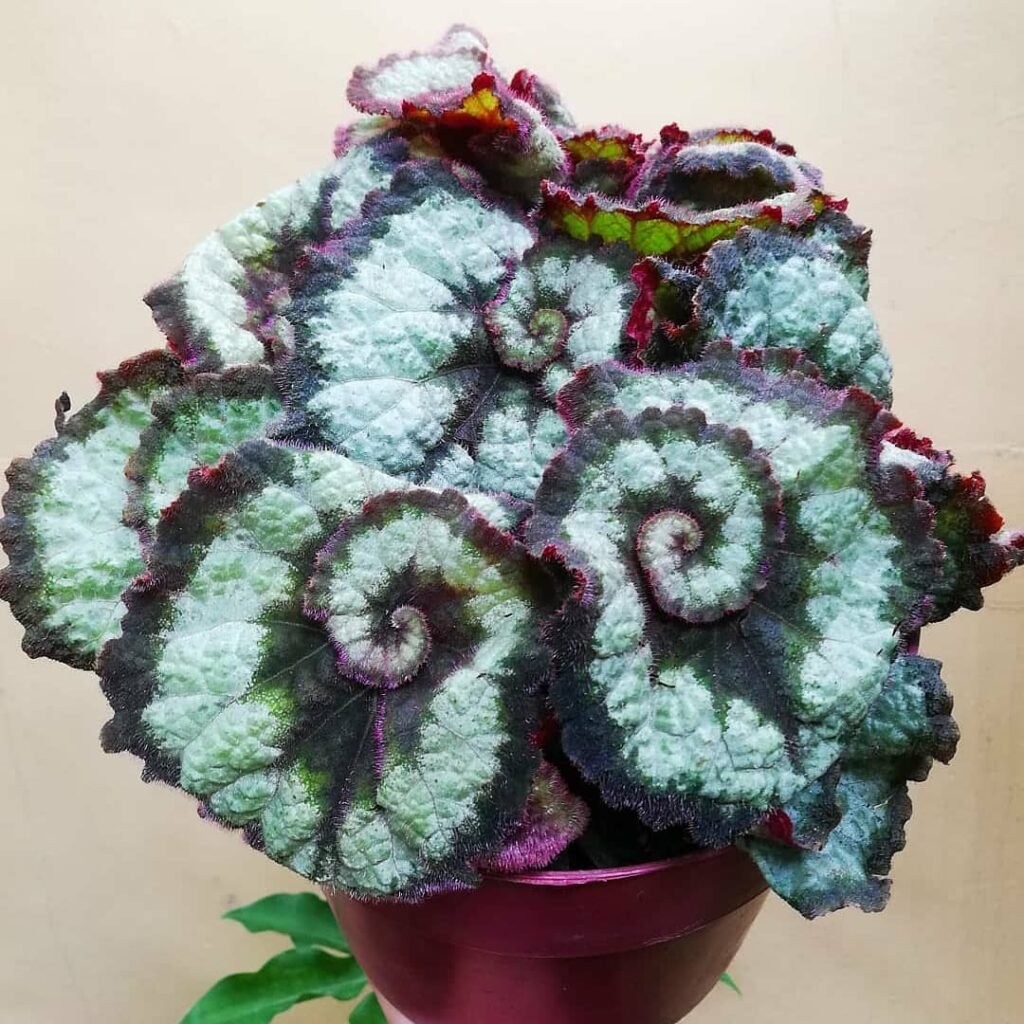
Genus Species
To understand Begonia Escargot better, let’s delve into its genus and species.
Begonia Genus:
Begonias belong to a large and diverse genus of flowering plants, consisting of more than 1,800 known species. They are native to tropical and subtropical regions, making them well-suited for indoor cultivation. Common features of begonias include asymmetrical leaves and intricate, often colorful flowers.
Begonia Escargot Species:
Begonia Escargot falls under the species “rex-cultorum.” This species is renowned for its stunning foliage and is highly favored as a decorative houseplant. It’s important to note that Begonia Escargot is a cultivar, meaning it has been specifically bred and selected for its unique characteristics, including the distinctive spiral pattern on its leaves.
Begonia Escargot Appearance
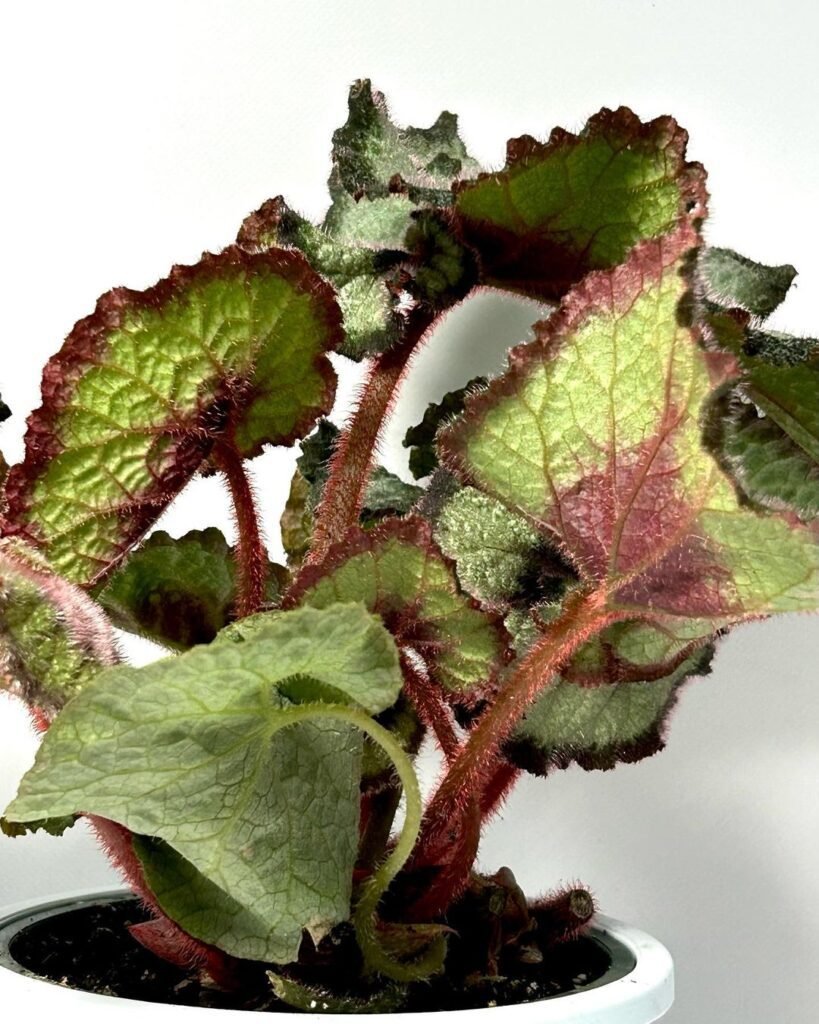
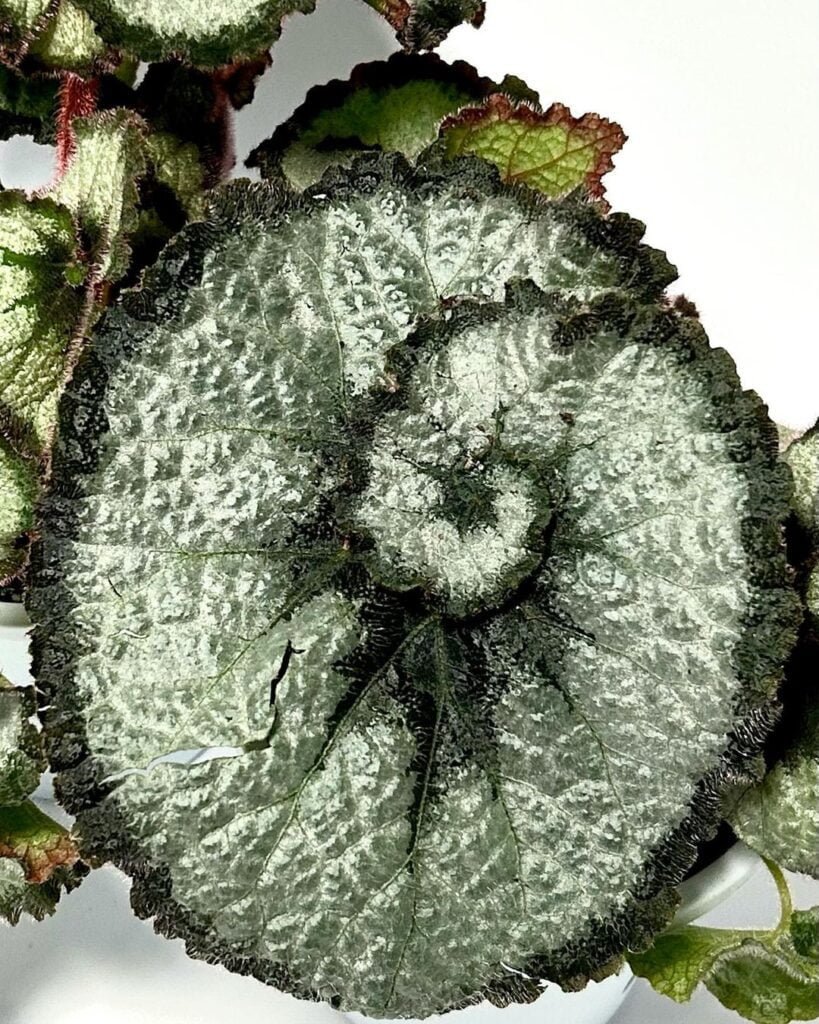
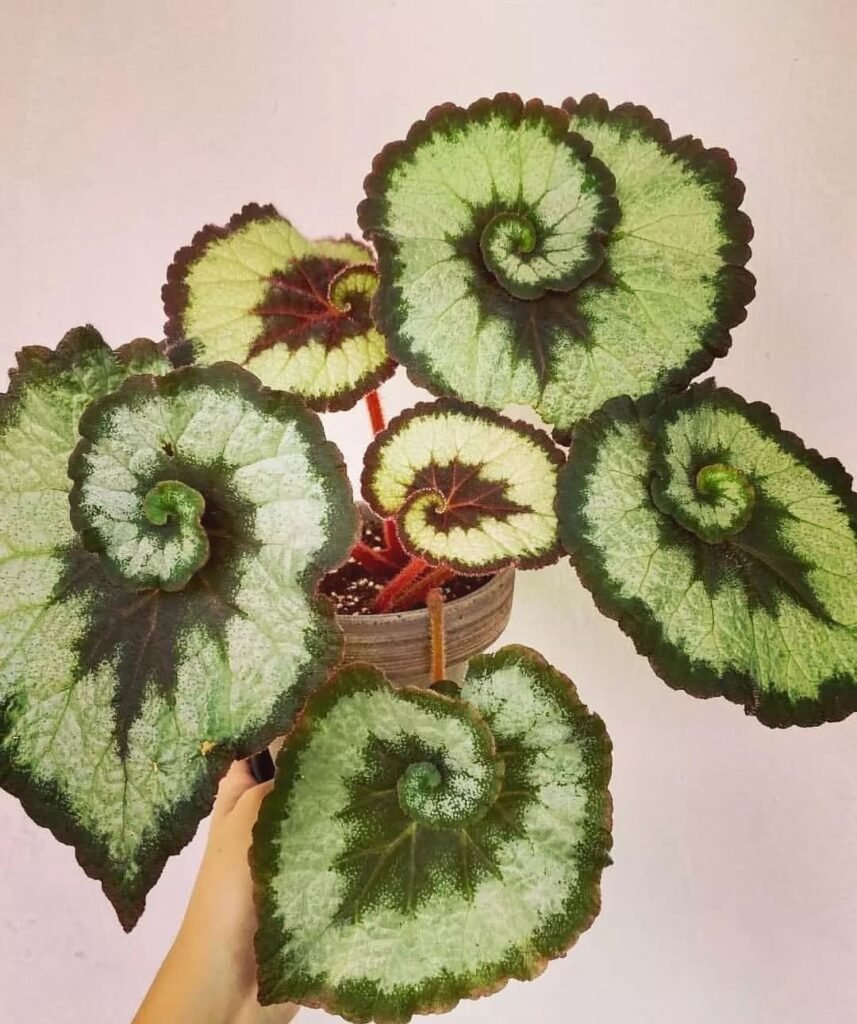
The appearance of Begonia Escargot is what truly sets it apart. Let’s explore its unique aesthetics.
Spiral Leaves:
The most prominent feature of Begonia Escargot is its striking leaves. The leaves are asymmetrical and exhibit a mesmerizing spiral pattern. The silvery-white center contrasts beautifully with the deep green veins and edges, creating an appealing focal point. This unique characteristic is why it’s often referred to as the “Snail Begonia.”
Compact Growth:
Begonia Escargot maintains a compact growth habit, with a bushy and slightly mounded form. It typically reaches a height of 12-18 inches, making it a suitable choice for tabletops, shelves, or small spaces.
Leaf Size:
The leaves of Begonia Escargot are typically 5-6 inches in length, making them a substantial part of its overall visual charm.
Flowering:
While the primary attraction is its foliage, Begonia Escargot may also produce small, inconspicuous pink or white flowers. However, most growers focus on the leaves, as they are the true stars of this plant.
Not the plant for you? Check out my full list of 78 Types of Begonia!
Begonia Escargot Care Tips
To ensure that your Begonia Escargot thrives and maintains its unique charm, it’s important to follow some care tips. Here’s what you need to know:
Table: Begonia Escargot Care Summary
| Care Aspect | Recommendations |
|---|---|
| Light Requirements | Bright, indirect sunlight. Avoid direct sun. |
| Soil Type | Well-draining, peat-based mix. |
| Watering | Keep soil consistently moist but not soggy. |
| Humidity & Temperature | High humidity (50-60%). Ideal temp: 65-75°F. |
| Fertilizing | Use a balanced liquid fertilizer monthly. |
| Pruning & Shaping | Regularly remove dead or damaged leaves. |
| Propagation & Repotting | Propagate through stem cuttings. Repot if root-bound. |
Light Requirements:
Begonia Escargot thrives in bright, indirect sunlight. Avoid exposing it to direct sunlight, as it can scorch the delicate leaves. A north or east-facing window is typically ideal, or you can use sheer curtains to filter the light.
Soil Type:
Ensure your Begonia Escargot is planted in well-draining soil. A peat-based mix with added perlite or vermiculite works well. This allows for proper aeration and prevents overwatering issues.
Watering:
Maintain consistent moisture in the soil, but avoid keeping it soggy. Water the plant when the top inch of soil feels dry. Be cautious not to let it sit in standing water, as this can lead to root rot.
Humidity & Temperature:
Begonia Escargot thrives in high humidity, ideally around 50-60%. To achieve this, you can use a humidity tray or a room humidifier. Keep the temperature in the range of 65-75°F (18-24°C) for optimal growth.
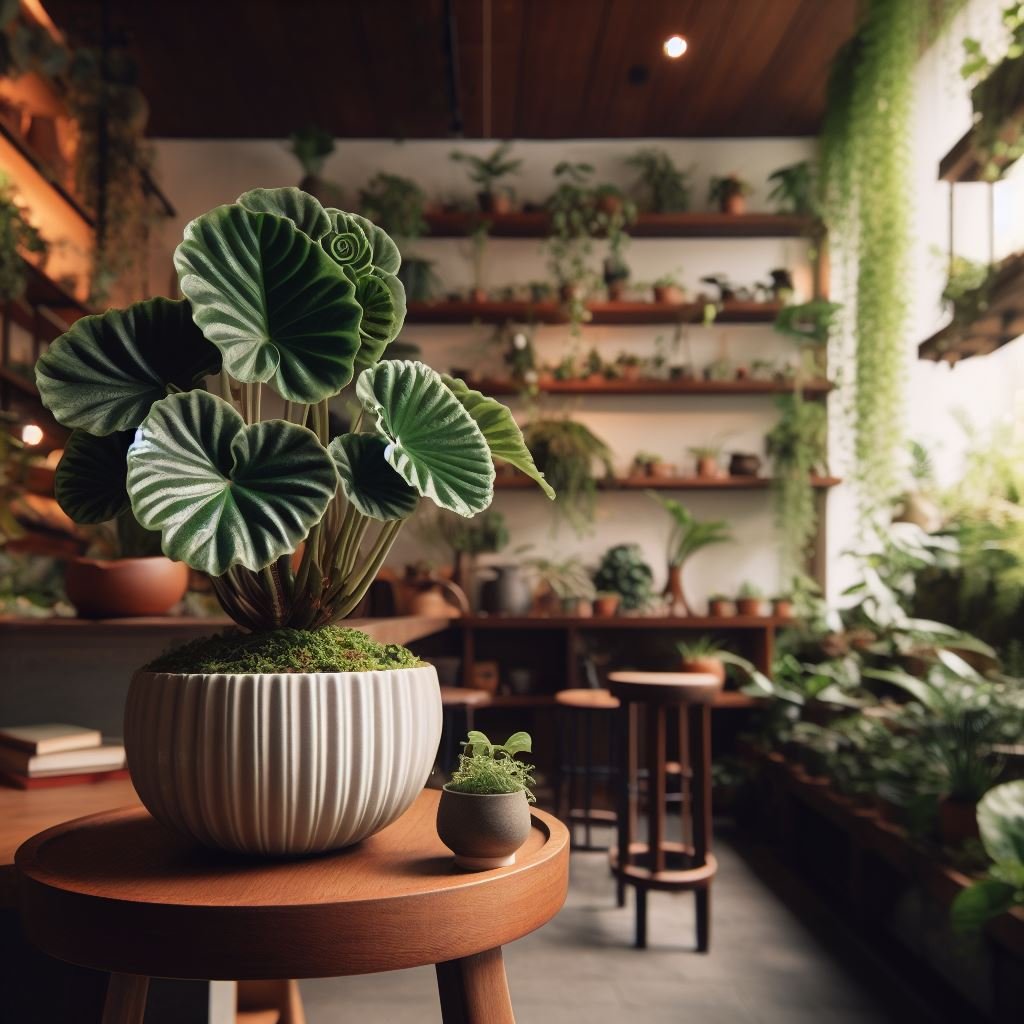
Watering Begonia Escargot
Proper watering is crucial for the health of your Begonia Escargot. Let’s delve deeper into the specifics of watering this unique plant.
Frequency:
Water your Begonia Escargot when the top inch of the soil feels dry to the touch. This typically translates to watering every 1-2 weeks, but be sure to adjust based on your indoor climate and humidity levels.
Watering Method:
Use room-temperature water to avoid shocking the plant. Water the soil directly, being mindful not to splash the leaves. Water thoroughly until you see it draining from the pot’s bottom.
Drainage:
Good drainage is essential to prevent waterlogged roots. Ensure that the pot has drainage holes, and any excess water can escape easily.
Overwatering Warning:
One of the most common mistakes is overwatering. Begonia Escargot is sensitive to excessive moisture, so it’s crucial to avoid keeping the soil consistently wet. Signs of overwatering include yellowing leaves and wilting.
By following these watering guidelines, you’ll maintain the proper moisture balance and keep your Begonia Escargot thriving.
Begonia Escargot Humidity and Temperature

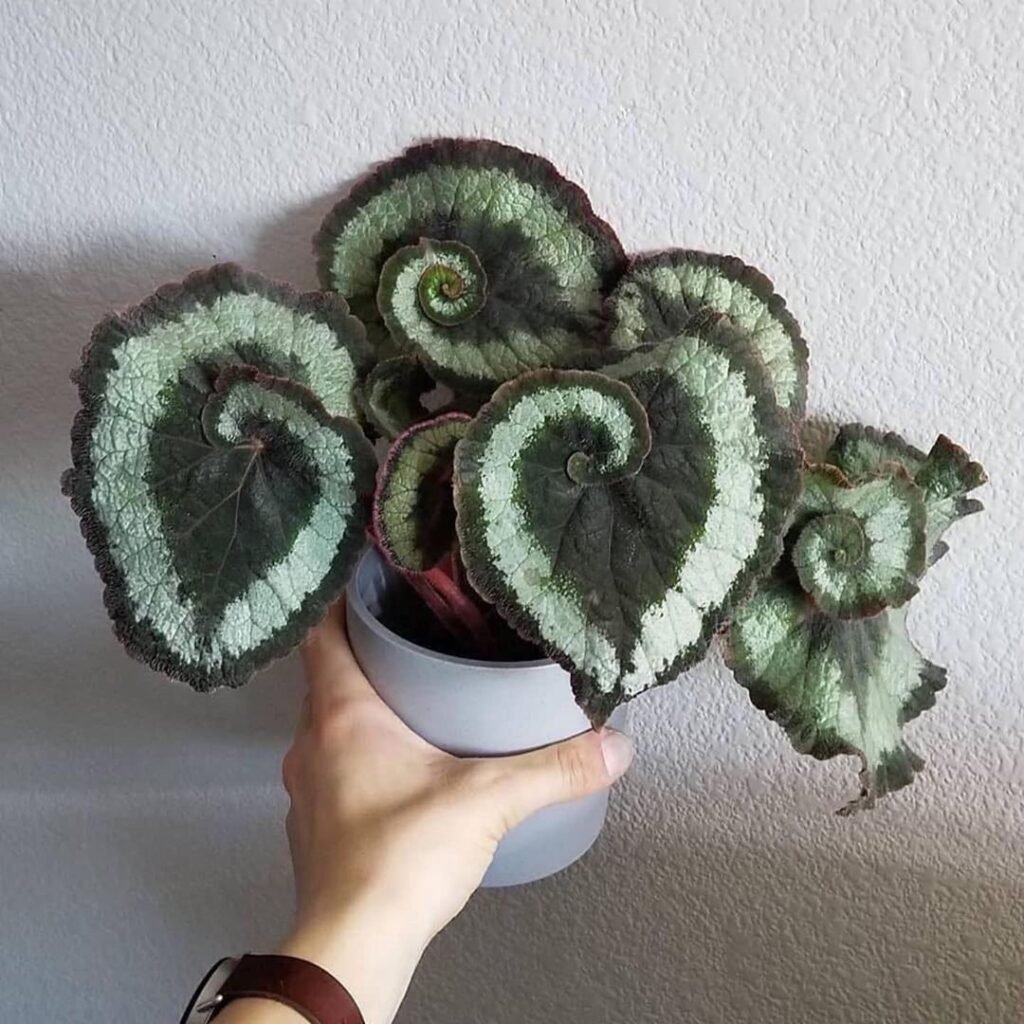
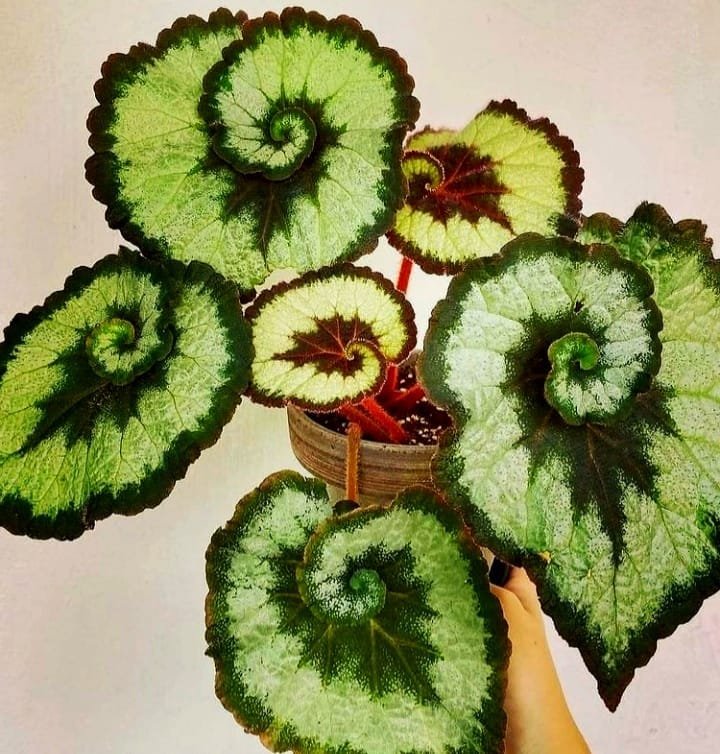
Creating the right environment for your Begonia Escargot’s humidity and temperature needs is essential for its well-being. Let’s explore how to achieve these conditions.
Humidity Requirements:
Begonia Escargot thrives in high humidity, typically around 50-60%. To boost humidity, consider the following:
- Use a humidity tray: Fill a shallow tray with water and place it near your plant. As the water evaporates, it increases the humidity around the Begonia.
- Room humidifier: Running a room humidifier is an effective way to maintain consistent humidity levels, especially in drier indoor environments.
Temperature Range:
Maintain a temperature range of 65-75°F (18-24°C) for your Begonia Escargot. Avoid exposing it to drafts, sudden temperature fluctuations, or extreme cold. If you can provide a stable and comfortable room temperature, your plant will flourish.
By paying attention to humidity and temperature, you’ll create the ideal conditions for your Begonia Escargot, ensuring its continued growth and vibrancy.
Fertilizing Begonia Escargot
Fertilizing your Begonia Escargot is essential to support its growth and maintain its captivating foliage. Here’s how to do it effectively:
Fertilizer Type:
Use a balanced liquid fertilizer with a formula like 20-20-20 or 10-10-10. This provides essential nutrients without overfeeding. Dilute the fertilizer to half strength to avoid overfertilization.
Frequency:
Fertilize your Begonia Escargot once a month during the growing season, typically from spring to early autumn. Reduce or cease fertilization during the dormant period in winter.
Application:
Apply the diluted fertilizer to damp soil to prevent root damage. Be cautious not to allow the fertilizer to touch the leaves, as it can cause burns. Water the plant after fertilizing to distribute the nutrients evenly.
Signs of Over-Fertilization:
Watch out for signs of over-fertilization, such as yellowing or browning leaf edges. If you notice these symptoms, flush the soil with water to remove excess nutrients.
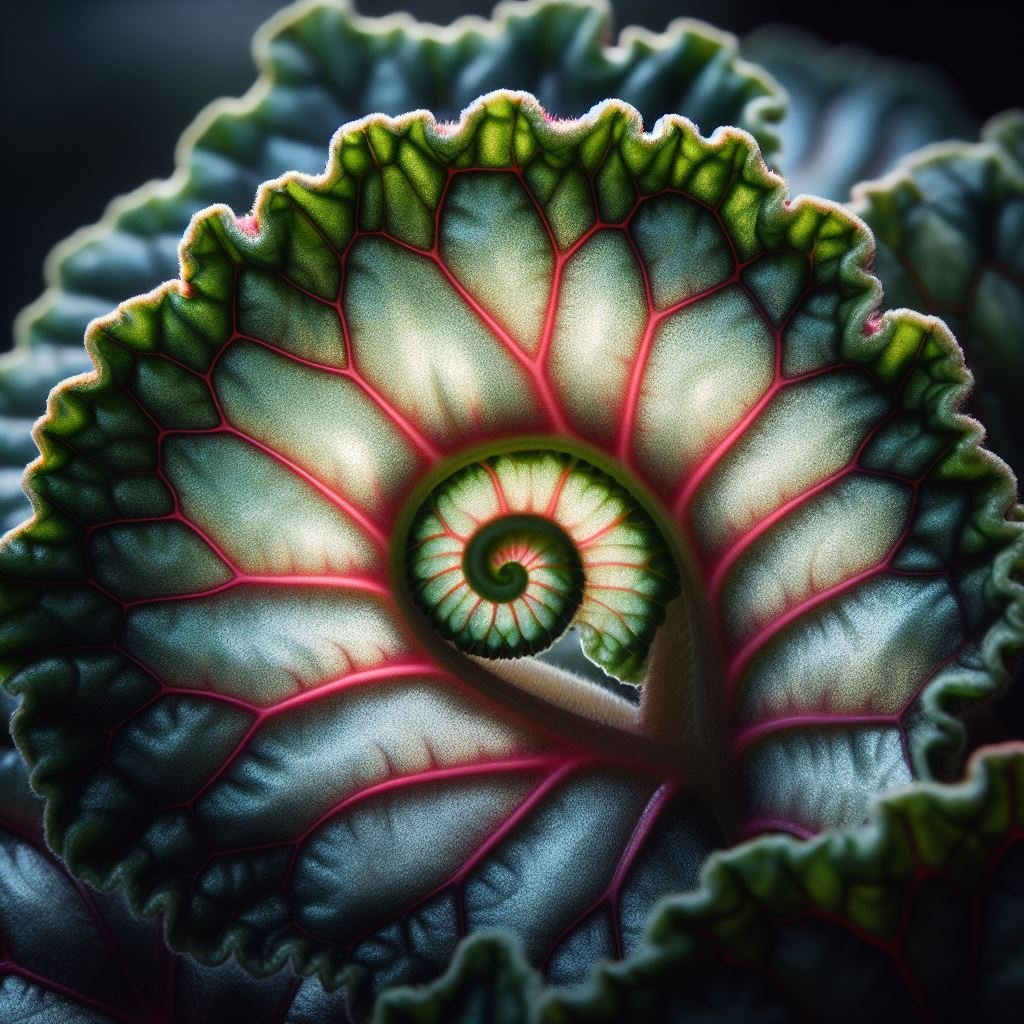
Begonia Escargot Pruning and Shaping
Pruning and shaping your Begonia Escargot not only help maintain its appearance but also promote healthy growth. Here are some tips:
Dead or Yellow Leaves:
Regularly inspect your plant for dead or yellowing leaves. Use clean, sharp scissors or pruning shears to trim these leaves at their base. This encourages new growth and prevents the spread of diseases.
Leggy Growth:
If your Begonia Escargot becomes leggy (with long stems and sparse foliage), you can prune it to maintain a bushier appearance. Simply trim the stems back to a desirable length.
Pinching:
To create a fuller and more compact plant, pinch the tips of young shoots. This promotes branching and lush growth.
Propagation from Cuttings:
The cuttings you prune from your Begonia Escargot can be used for propagation. Dip the cut end in rooting hormone and plant it in a separate pot with well-draining soil.
By regularly pruning and shaping your Begonia Escargot, you’ll ensure it remains healthy and visually appealing.
Begonia Escargot Propagation and Repotting
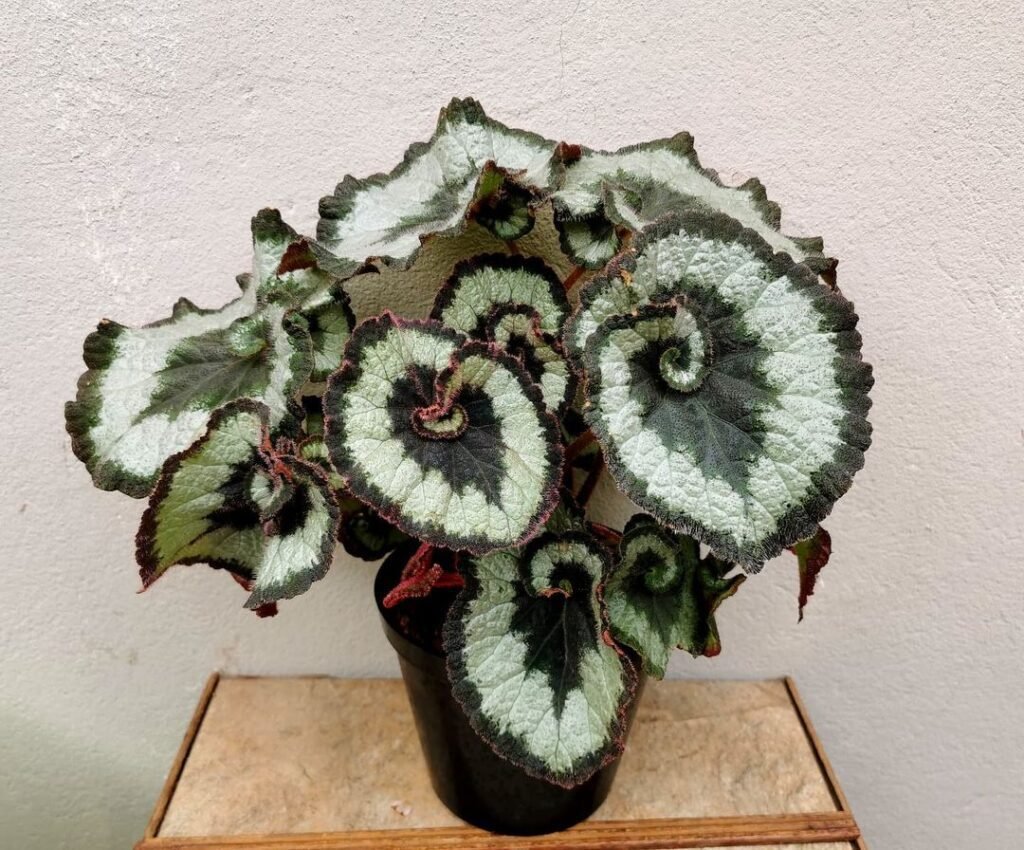


As your Begonia Escargot matures, you may need to propagate it or repot it for optimal growth. Here’s how to go about it:
Propagation:
Begonia Escargot can be propagated through stem cuttings. Here’s a simple guide:
- Take a 4-6 inch cutting with at least one leaf.
- Dip the cut end in rooting hormone.
- Plant the cutting in a pot with well-draining soil.
- Keep the soil consistently moist until roots develop.
Repotting:
Repot your Begonia Escargot when it outgrows its current container or becomes root-bound. Typically, this is required every 2-3 years. Choose a slightly larger pot with good drainage.
- Gently remove the plant from its current pot.
- Prune any damaged or excessive roots.
- Place the plant in the new pot with fresh potting mix.
- Water it thoroughly after repotting.
By following these guidelines for propagation and repotting, you’ll help your Begonia Escargot thrive in a larger and healthier space.
Begonia Escargot Seasonal Care
Begonia Escargot’s care requirements may vary with the changing seasons. Here’s how to adjust your care routine:
Spring and Summer:
During the growing season, provide moderate humidity, bright but indirect sunlight, and regular fertilization. Keep the soil consistently moist but not soggy.
Fall:
As the days grow shorter, reduce the frequency of fertilization. Continue to maintain humidity and ensure the plant receives adequate indirect light.
Winter:
In the dormant period, reduce watering frequency and halt fertilization. Maintain moderate humidity levels. Protect your Begonia Escargot from cold drafts and temperature fluctuations.
Begonia Escargot Companion Plants
Choosing the right companion plants for your Begonia Escargot can enhance the overall aesthetic of your indoor garden. Here are some suitable options:
| Companion Plant | Features |
|---|---|
| Ferns | Create a lush, tropical atmosphere. |
| Ivies | Trailing vines add an elegant touch. |
| Calathea | Complement Begonia Escargot’s unique leaves. |
| Fittonia | Small, colorful foliage for contrast. |
| Orchids | Elegance and a diverse range of colors. |
| Pothos | Versatile and easy-care trailing plant. |
Selecting the right companion plants can create an eye-catching and harmonious display in your indoor garden.
Pest Control Tips for Begonia Escargot
While Begonia Escargot is relatively low-maintenance, it can still fall victim to common houseplant pests. Here’s how to keep them at bay:
Common Pests:
- Aphids: These tiny insects can suck sap from the leaves, causing them to yellow and distort.
- Mealybugs: Mealybugs appear as small, cottony clusters and can damage the foliage.
- Spider Mites: These microscopic pests can create fine webbing on the plant and cause stippling on the leaves.
Pest Control Methods:
- Regular Inspection: Routinely check your Begonia Escargot for signs of pests, including webbing, discoloration, and visible insects.
- Isolation: If you identify an infestation, consider isolating the affected plant to prevent the pests from spreading.
- Insecticidal Soap: Use a diluted insecticidal soap solution to spray and treat the plant. Ensure it reaches all leaf surfaces.
- Neem Oil: Neem oil is an effective and natural pesticide that can help control various pests. Apply it according to the instructions on the product.
- Pruning: Remove severely affected or infested leaves to prevent the issue from spreading.
By staying vigilant and taking action at the first signs of pest trouble, you can keep your Begonia Escargot healthy and vibrant.
Reviving a Sick or Wilting Begonia Escargot
If your Begonia Escargot is showing signs of stress or wilting, there are steps you can take to revive it:
Signs of Distress:
- Yellowing or wilting leaves.
- Excessive leaf drop.
- Dry and brittle foliage.
- Slow or stunted growth.
Revival Steps:
- Assess Watering: Check if you’ve been overwatering or underwatering your plant. Adjust the watering frequency accordingly.
- Inspect Roots: If the plant is severely stressed, carefully remove it from its pot and check the roots. Trim any rotting or damaged roots.
- Pruning: Trim away unhealthy or dead leaves to encourage new growth.
- Increase Humidity: If your plant shows signs of dehydration, increase humidity levels by using a humidity tray or humidifier.
- Proper Lighting: Ensure your Begonia Escargot is getting the right amount of bright, indirect light.
- Fertilize Sparingly: Avoid fertilizing when the plant is stressed. Wait until it shows signs of recovery.
With patience and the right care adjustments, you can often revive a sick or wilting Begonia Escargot and restore its health and beauty.
FAQs
Can I place my Begonia Escargot in direct sunlight?
No, it’s best to provide bright, indirect sunlight. Direct sun can scorch the leaves.
How often should I water my Begonia Escargot?
Water when the top inch of soil feels dry, typically every 1-2 weeks. Adjust based on your home’s humidity levels.
What’s the ideal humidity for Begonia Escargot?
Aim for 50-60% humidity. You can use a humidity tray or room humidifier to achieve this.
Can I propagate my Begonia Escargot from leaf cuttings?
While stem cuttings are more common, you can try leaf cuttings, though they may take longer to root.
Why is my Begonia Escargot dropping leaves?
Leaf drop can be due to overwatering, underwatering, or changes in the environment. Check your care routine to address the issue.
Conclusion
In conclusion, Begonia Escargot, with its captivating spiral leaves, is a stunning addition to any indoor garden. By understanding its unique characteristics and following the care guidelines provided, you can ensure that your Begonia Escargot thrives and remains a focal point in your home. Whether you’re a seasoned plant enthusiast or a beginner, the beauty of this begonia variety will undoubtedly leave you enchanted. Happy gardening!
Love all types of Begonia? Make sure to catch up on my post on how to care and grow for Rieger Begonia. After you’ve finished reading that, why not also check out my care guide on how to grow Beefsteak Begonia.

Writer/Green Thumb/Explorer – Rooted deep in the rich soils of Devon, I’ve cultivated a vast expertise in plant care, helping greenery thrive in homes across the UK. When I’m not crafting detailed plant care guides, I’m journeying through the lush landscapes of the West Country, unearthing nature’s secrets and sharing them with fellow plant enthusiasts. Every leaf has a story, and I’m here to tell it.





